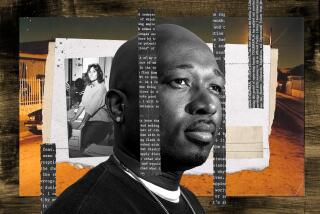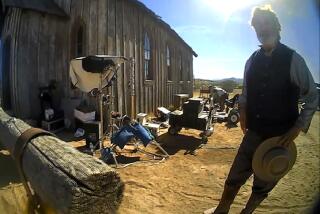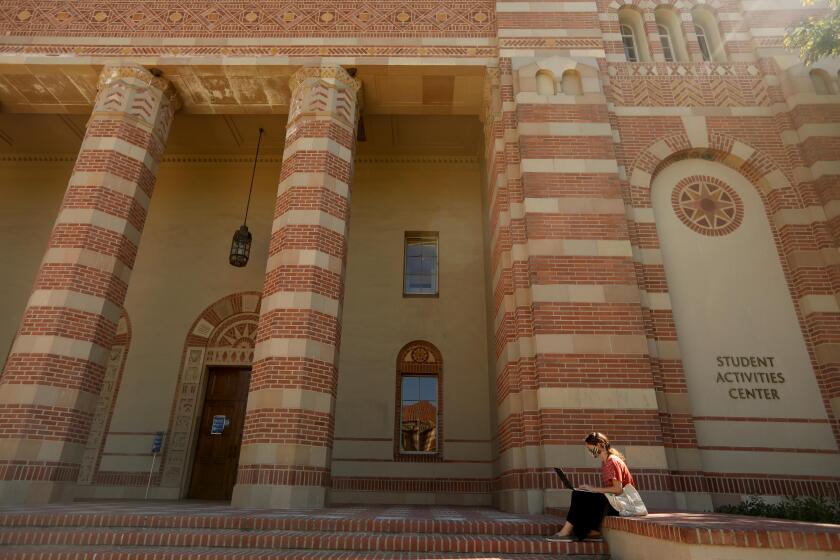Coroner’s Official Testifies Father Did Not Kill Son
- Share via
Rebutting the theory that defendant Kenneth Crandell shot Ernest Pruett in self-defense, a criminologist testified Monday that Pruett had not fired the gun that killed both him and his son during the notorious double-homicide in North Hollywood nearly 20 years ago.
“There were no gunshot residue particles on [Pruett’s] hands,” said Steven Dowell, an expert in the field with the Los Angeles County coroner’s office, during Crandell’s murder trial in Van Nuys Superior Court. “He did not discharge the firearm.”
Crandell has been accused of the July 1980 murder of Pruett, who was 69, and his 14-year-old son, Edward. A family friend who was boarding at the Pruett home, Crandell allegedly shot the elder Pruett after an argument and then killed the boy, who was there at the time. Crandell is also charged with kidnapping Pruett’s two daughters and assaulting them with intent to rape.
Defense attorney Michael V. White contended earlier that Pruett had shot his son with Crandell’s gun during an alcoholic rage, and that Crandell subsequently killed the elder Pruett in self-defense.
But tests performed nearly two decades ago suggest otherwise, according to Dowell.
When questioned by Deputy Dist. Atty. Lea Purwin D’Agostino, Dowell said that the murder weapon, a 38-caliber Smith & Wesson revolver, leaves unique chemical particles on hands that pull its trigger. Some particles can be easily blown or wiped off skin, but others can stick to pores, Dowell said.
*
White suggested that gunshot residue could have been wiped off Pruett’s hand during a “violent struggle” with Crandell.
That could be true, Dowell said. But tests showed that there were other chemical particles, such as chlorine, iron and sulfur found on the elder Pruett’s hands that were not gunshot residue. It is extremely unlikely that gunshot residue would be wiped off while other particles remain, said Dowell, who also testified at Crandell’s first trial for the double murder in 1981.
Crandell was found guilty of first-degree murder then and was sentenced to death in 1982, but a series of successful appeals has brought him ever closer to freedom.
In 1988, the state Supreme Court reversed his death sentence. In 1996, a federal district court found that the deputy public defender Crandell briefly used was incompetent, even though Crandell’s trial judge at the time praised the courtroom performance of the defendant, who chose to represent himself. The 9th Circuit Court of Appeals then remanded the case for retrial.
Because so much time has passed since the first trial, prosecuting the case presents formidable challenges.
“All the evidence in People versus Crandell was erroneously destroyed in 1994,” D’Agostino told jurors in the courtroom of Los Angeles County Superior Court Judge Sandy R. Kriegler.
Witnesses have died, including the coroner’s investigator who tested Pruett’s hands for gunshot residue. So Monday, a couple of witnesses, including Dowell, had to corroborate what that investigator did.
*
A former neighbor of Pruett’s, Miguel Moreno, testified that the defendant confessed to the murders.
Some hours after the crime, Crandell drove to Moreno’s home, he said. “He said he had a big problem,” Moreno said. “He told me that . . . ‘I just killed Ernie and Edward.’ ”
Crandell then asked Moreno to help him dump the bodies in the hills and threatened to kill him and his family if he didn’t cooperate.
But Crandell later told another version of how the shootings occurred, Moreno said. In Crandell’s second telling, he and the elder Pruett struggled over a gun and it went off, killing the boy; then Crandell killed Pruett, Moreno testified.
The latter explanation was all that Moreno told police at the time, White pointed out, adding that Moreno had not said until recently that Crandell threatened his family or admitted killing both father and son.
Moreno replied that he was scared and was in a hurry to go home because he was ill at the time.
More to Read
Sign up for Essential California
The most important California stories and recommendations in your inbox every morning.
You may occasionally receive promotional content from the Los Angeles Times.










